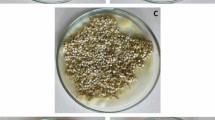Abstract
In this study, the effects of conventional and microwave roasting on phenolic compounds, free acidity, peroxide value, fatty acid composition and tocopherol content of pecan walnut kernel and oil was investigated. The oil content of pecan kernels was 73.78% for microwave oven roasted at 720 W and 73.56% for conventional oven roasted at 110 °C. The highest free fatty acid content (0.50%) and the lowest peroxide value (2.48 meq O2/kg) were observed during microwave roasting at 720 W. The fatty acid profiles and tocopherol contents of pecan kernel oils did not show significant differences compared to raw samples. Roasting process in microwave oven at 720 W caused the reduction of some phenolic compounds, while the content of gallic acid exhibited a significant increase.
Similar content being viewed by others
References
Anderson KJ, Teuber SS, Gobeille A, Cremin P, Waterhouse AL, Steinberg FM (2001) Walnut polyphenolics inhibit in vitro human plasma and LDL oxidation. J Nutr 131:2837–2842
AOAC (1990) Official Methods of Analysis, 15th edn. Association of Official Analytical Chemists, Washington
AOCS (1989) Official methods and recommended practices of the American Oil Chemists’Society, 4th edn. American Oil Chemists’ Society, Champaign, Method, pp 5–41
AOCS (1992) Official methods and recommended practices of the American Oil Chemists’ Society, 4th edn. American Oil Chemists’ Society, Champaign, Method Cd, pp 8–53
Arinola SO, Adesina K (2014) Effect of thermal processing on the nutritional, antinutritional, and antioxidant properties of Tetracarpidium conophorum (African walnut). J Food Process 1–4
Azadmard-Damirchi S, Emami Sh, Hesari J, Peighambardoust SH, Nemati M (2011) Nuts composition and their health benefits. Int J Biol Biomol Agric, Food Biotechnol Eng 544–548
Berteli MN, Marsaioli A Jr (2005) Evaluation of short cut pasta air dehydration assisted by microwaves as compared to the conventional drying process. J Food Eng 68:175–183
Cang SK, Alasalvar C, Bolling BW, Shahidi F (2016) Nuts and their co-products: the impact of processing (roasting) on phenolics, bioavailability, and healh benefits—a comprehensive review. J Funct Foods 26:88–122
ISO-International Organization for Standardization (1978) Animal and vegetable fats and oils preparation of methyl esters of fatty acids, ISO. Geneve, Method ISO 5509, pp 1–6
Kowalski B (1991) Thermal oxidative decomposition of edible oil and fats: DSC studies. Thermochim Acta 184:49–57
Magnuson SM, Kelly B, Koppel K, Reid W (2016) A comparison of flavor differences between pecan cultivars in raw and roasted forms. J Food Sci 81(5):1243–1253
Mertens-Talcott SU, Percival SS (2005) Ellagic acid and quercetin interact synergistically with resveratrol in the induction of apoptosis and cause transient cell cycle arrest in human leucemia cells. Cancer Lett 218:141–151
Püskülcü H, İkiz F (1989) Introduction to statistic. Bilgehan Press, Bornova, p 333 (in Turkish)
Qu Q, Yang X, Fu M, Chen Q, Zhang X, He Z, Qiao X (2016) Effect of three conventional drying methods on the lipid oxidation, fatty acid composition, and antioxidant activities of walnut (Juglans regia L.). Drying Technol 34(7):822–829
Saklar S, Ungan S, Katnas S (1999) Instrumental crispness and crunchiness of roasted hazelnuts and correlations with sensory assessment. J Food Sci 64:1015–1019
Santos JCO, Santos IMG, Conceição MM, Sl Porto, Trindade MFS, Souza AG, Prasad S, Fernandes Junior VJ, Araújo AS (2004) Thermoanalytical, kinetic and rheological parameters of commercial edible vegetable oils. J Thermal Anal Calorim 75:419–428
Silva FA, Marsaioli A Jr (2003) Drying Brazil nuts using hot air assisted by microwaves compared to conventionally dried samples. In: Binner J (ed) Proceedings of the 9th International conference on microwave and the high frequency heating. Loughborough, UK, Sept 1–5, pp 341–344
Silva FA, Marsaioli A Jr, Maximo GJ, Silva MAAP, Goncalves LA (2006) Microwave assisted drying of macadamia nuts. J Food Eng 77(3):550–558
Slatnar A, Mikulic-Petkovsek M, Stampar F, Veberic B, Solar A (2015) Identification and quantification of phenolic compounds kernels, oil and bagasse of common walnut (Juglans regia L.). Food Res Int 67:255–263
Spika MJ, Kraljic K, Koprivnjak O, Skevin D, Zanetic M, Katalinic M (2015) Effect of agronomical factors and storage conditions on the tocopherol content of Oblica and Leccino virgin olive oil. J Am Oil Chem Soc 92:1293–1301
Tam NN, Nyska A, Maronpot RR, Kissling G, Lomnitski L, Suttie A, Balshi S, Bergman M, Grossman S, Ho SM (2006) Differential attenuation of oxidative/nitrosative injuries in early prostatic neoplastic lesions in TRAMP mice by dietary antioxidants. Prostate 66:57–69
Vaidya B, Eun JB (2013) Effect of roasting on oxidative and tocopherol stability of walnut oil during storage in the dark. Eur J Lipid Sci Technol 115:348–355
Wesolowski M, Erecinska J (1998) Thermal analysis in quality assessment of rapeseed oils. Thermochim Acta 323:137–143
Yang J, Zhou F, Xiong L, Mao S, Hu Y, Lu B (2015) Comparison of phenolic compounds, tocopherols, phytosterols and antioxidant potential in Zhejiang pecan [Carya cathayensis] at different stir-frying steps. LWY-Food Sci Technol 62:541–548
Acknowledgements
The authors extend their appreciation to the International Scientific Partnership Program ISPP at King Saud University for funding this research work through ISPP# 0015.
Author information
Authors and Affiliations
Corresponding author
Rights and permissions
About this article
Cite this article
Juhaimi, F.A., Özcan, M.M., Uslu, N. et al. Pecan walnut (Carya illinoinensis (Wangenh.) K. Koch) oil quality and phenolic compounds as affected by microwave and conventional roasting. J Food Sci Technol 54, 4436–4441 (2017). https://doi.org/10.1007/s13197-017-2921-0
Revised:
Accepted:
Published:
Issue Date:
DOI: https://doi.org/10.1007/s13197-017-2921-0




